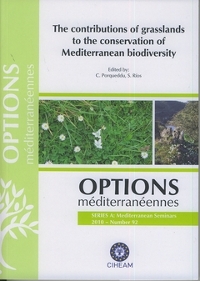| Article précédent | p. 125-128 | Article suivant |
Yield and nutritive value of cereal-legume forage mixtures as an alternative to Italian ryegrass used as a winter crop in Galicia (NW Spain)
The aim of the present work was to transfer to dairy farms research results achieved during the last eight years on mixtures made of triticale (x Triticosecale Wittm.) and pea (Pisum sativum L.) (t-p), triticale and vetch (Vicia sativa L.) (t-v) and triticale and fava bean (Vicia faba L.) (t-f) to be compared with Italian ryegrass (Lolium multiflorum L.) as the winter phase of a two-crops per year rotation with forage maize (Zea mays L.), which is widely used but that shows some management problems. Fields were planted in autumn 2006 and harvested in spring 2007 in farms associated to the following cooperatives, located in different regions of Galicia: Os Irmandiños (A Mariña Oriental and Terra Chá), Melisanto (Terra de Melide), Feiraco (Xallas) and Cobideza (Deza). Yield (Y, t/ha DM), crude protein content (CP, percent DM) and neutral detergent fibre (NDF, percent DM) values varied according with the following intervals for the different mixtures and for the Italian ryegrass monoculture: t-p (Y: 4.3-7.5; CP: 13.7-18.7; NDF: 44.1-56.2), t-v (Y: 3.0-6.4; CP: 11.2-19.4; NDF: 50.8-58.6), t-f (Y: 4.4-4.8; CP: 11.1-11.9; NDF: 39.2-43.4), Italian ryegrass (Y: 5.0-8.2; CP: 7.8-12.4; NDF: 54.3-55.7).
L'objectif du présent travail est de transférer les résultats des recherches réalisées au cours des huit dernières années aux exploitations laitières. Les auteurs ont comparé le ray-grass italien (Lolium multiflorum L.) avec des mélanges de triticale (x Triticosecale Wittm.) et pois (Pisum sativum L.) (t-p), de triticale et vesce (Vicia sativa L.) (t-v) et de triticale et féverole (Vicia faba L..) (t-f) comme phase d'hiver d'une rotation de deux cultures par an avec du maïs fourrager (Zea mays L.), ce qui est largement pratiqué, mais qui soulève quelques problèmes de gestion. Les champs ont été plantés à l'automne 2006 et récoltés au printemps 2007 dans des fermes associées aux coopératives suivantes, situées dans différentes régions de Galice : Os Irmandiños (A Mariña Oriental et Terra Chá), Melisanto (Terra de Melide), Feiraco (Xallas) et Cobideza (Deza). Les valeurs du rendement (R, t/ha MS), de la teneur en matières azotées totales (MAT, pour cent MS) et en fibre neutro-détergente (FDN, pour cent MS) varient pour les différents mélanges et pour la monoculture de ray-grass italien dans les intervalles suivants: t-p (R : 4,3-7,5 ; MAT : 13,7-18,7 ; FDN : 44,1-56,2), t-v (R : 3,0-6,4 ; MAT : 11,2-19,4 ; FDN : 50,8-58,6), t-f (R : 4,4-4,8 ; MAT : 11,1-11,9 ; FDN : 39,2-43,4), Ray-grass italien (R : 5,0-8,2 ; MAT : 7,8-12,4 ; FDN : 54,3-55,7).
- [ Afficher ]
- [ Télécharger ]
- [ Exporter la citation ]
Vous pouvez télécharger la citation au format :
- [ Imprimer ]
-
Mots-clés
CEREALE FOURRAGERE, CULTURE EN MELANGE, ESPAGNE, LEGUMINEUSE FOURRAGERE, RENDEMENT DES CULTURES, ROTATION CULTURALE, VALEUR NUTRITIVECiter cet article
Bande-Castro M.J., Díaz Díaz N., Fernández-Paz J., Piñeiro-Andión J. Yield and nutritive value of cereal-legume forage mixtures as an alternative to Italian ryegrass used as a winter crop in Galicia (NW Spain). In : Porqueddu C. (ed.), Ríos S. (ed.). The contributions of grasslands to the conservation of Mediterranean biodiversity. Zaragoza : CIHEAM / CIBIO / FAO / SEEP, 2010. p. 125-128. (Options Méditerranéennes : Série A. Séminaires Méditerranéens; n. 92). 13. Meeting of the Sub-Network on Mediterranean Forage Resources of the FAO-CIHEAM International Network for the Research and Development of Pasture and Forage Crops, 2010/04/07-10, Alicante (Spain). http://om.ciheam.org/om/pdf/a92/00801229.pdf



